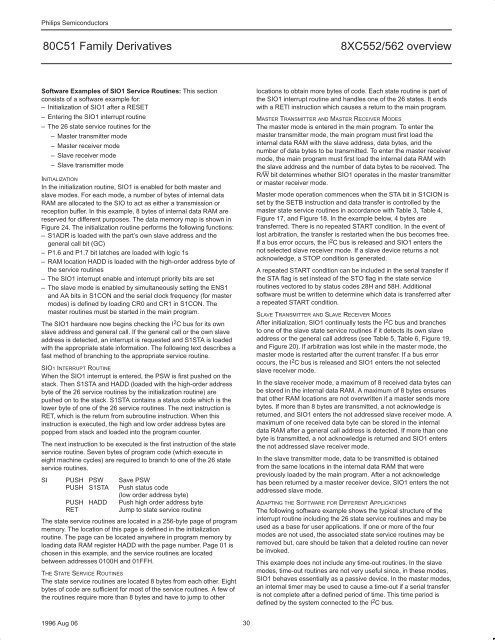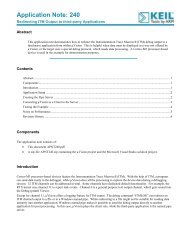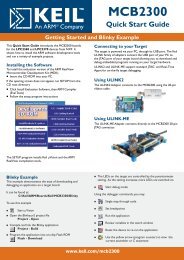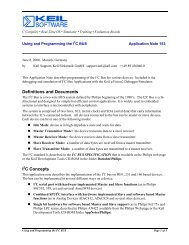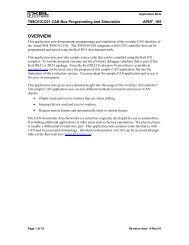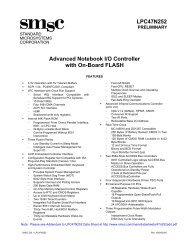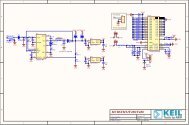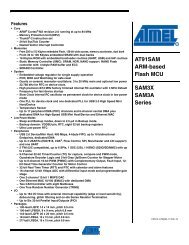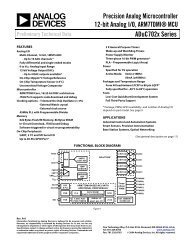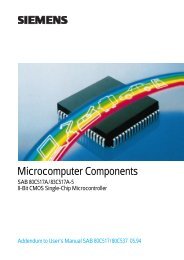NXP 80C552, 83/87C552, P80C562, P83C562 Family Overview - Keil
NXP 80C552, 83/87C552, P80C562, P83C562 Family Overview - Keil
NXP 80C552, 83/87C552, P80C562, P83C562 Family Overview - Keil
Create successful ePaper yourself
Turn your PDF publications into a flip-book with our unique Google optimized e-Paper software.
Philips Semiconductors<br />
80C51 <strong>Family</strong> Derivatives 8XC552/562 overview<br />
Software Examples of SIO1 Service Routines: This section<br />
consists of a software example for:<br />
– Initialization of SIO1 after a RESET<br />
– Entering the SIO1 interrupt routine<br />
– The 26 state service routines for the<br />
– Master transmitter mode<br />
– Master receiver mode<br />
– Slave receiver mode<br />
– Slave transmitter mode<br />
INITIALIZATION<br />
In the initialization routine, SIO1 is enabled for both master and<br />
slave modes. For each mode, a number of bytes of internal data<br />
RAM are allocated to the SIO to act as either a transmission or<br />
reception buffer. In this example, 8 bytes of internal data RAM are<br />
reserved for different purposes. The data memory map is shown in<br />
Figure 24. The initialization routine performs the following functions:<br />
– S1ADR is loaded with the part’s own slave address and the<br />
general call bit (GC)<br />
– P1.6 and P1.7 bit latches are loaded with logic 1s<br />
– RAM location HADD is loaded with the high-order address byte of<br />
the service routines<br />
– The SIO1 interrupt enable and interrupt priority bits are set<br />
– The slave mode is enabled by simultaneously setting the ENS1<br />
and AA bits in S1CON and the serial clock frequency (for master<br />
modes) is defined by loading CR0 and CR1 in S1CON. The<br />
master routines must be started in the main program.<br />
The SIO1 hardware now begins checking the I2C bus for its own<br />
slave address and general call. If the general call or the own slave<br />
address is detected, an interrupt is requested and S1STA is loaded<br />
with the appropriate state information. The following text describes a<br />
fast method of branching to the appropriate service routine.<br />
SIO1 INTERRUPT ROUTINE<br />
When the SIO1 interrupt is entered, the PSW is first pushed on the<br />
stack. Then S1STA and HADD (loaded with the high-order address<br />
byte of the 26 service routines by the initialization routine) are<br />
pushed on to the stack. S1STA contains a status code which is the<br />
lower byte of one of the 26 service routines. The next instruction is<br />
RET, which is the return from subroutine instruction. When this<br />
instruction is executed, the high and low order address bytes are<br />
popped from stack and loaded into the program counter.<br />
The next instruction to be executed is the first instruction of the state<br />
service routine. Seven bytes of program code (which execute in<br />
eight machine cycles) are required to branch to one of the 26 state<br />
service routines.<br />
SI PUSH PSW Save PSW<br />
PUSH S1STA Push status code<br />
(low order address byte)<br />
PUSH HADD Push high order address byte<br />
RET Jump to state service routine<br />
The state service routines are located in a 256-byte page of program<br />
memory. The location of this page is defined in the initialization<br />
routine. The page can be located anywhere in program memory by<br />
loading data RAM register HADD with the page number. Page 01 is<br />
chosen in this example, and the service routines are located<br />
between addresses 0100H and 01FFH.<br />
THE STATE SERVICE ROUTINES<br />
The state service routines are located 8 bytes from each other. Eight<br />
bytes of code are sufficient for most of the service routines. A few of<br />
the routines require more than 8 bytes and have to jump to other<br />
1996 Aug 06 30<br />
locations to obtain more bytes of code. Each state routine is part of<br />
the SIO1 interrupt routine and handles one of the 26 states. It ends<br />
with a RETI instruction which causes a return to the main program.<br />
MASTER TRANSMITTER AND MASTER RECEIVER MODES<br />
The master mode is entered in the main program. To enter the<br />
master transmitter mode, the main program must first load the<br />
internal data RAM with the slave address, data bytes, and the<br />
number of data bytes to be transmitted. To enter the master receiver<br />
mode, the main program must first load the internal data RAM with<br />
the slave address and the number of data bytes to be received. The<br />
R/W bit determines whether SIO1 operates in the master transmitter<br />
or master receiver mode.<br />
Master mode operation commences when the STA bit in S1CION is<br />
set by the SETB instruction and data transfer is controlled by the<br />
master state service routines in accordance with Table 3, Table 4,<br />
Figure 17, and Figure 18. In the example below, 4 bytes are<br />
transferred. There is no repeated START condition. In the event of<br />
lost arbitration, the transfer is restarted when the bus becomes free.<br />
If a bus error occurs, the I2C bus is released and SIO1 enters the<br />
not selected slave receiver mode. If a slave device returns a not<br />
acknowledge, a STOP condition is generated.<br />
A repeated START condition can be included in the serial transfer if<br />
the STA flag is set instead of the STO flag in the state service<br />
routines vectored to by status codes 28H and 58H. Additional<br />
software must be written to determine which data is transferred after<br />
a repeated START condition.<br />
SLAVE TRANSMITTER AND SLAVE RECEIVER MODES<br />
After initialization, SIO1 continually tests the I2C bus and branches<br />
to one of the slave state service routines if it detects its own slave<br />
address or the general call address (see Table 5, Table 6, Figure 19,<br />
and Figure 20). If arbitration was lost while in the master mode, the<br />
master mode is restarted after the current transfer. If a bus error<br />
occurs, the I2C bus is released and SIO1 enters the not selected<br />
slave receiver mode.<br />
In the slave receiver mode, a maximum of 8 received data bytes can<br />
be stored in the internal data RAM. A maximum of 8 bytes ensures<br />
that other RAM locations are not overwritten if a master sends more<br />
bytes. If more than 8 bytes are transmitted, a not acknowledge is<br />
returned, and SIO1 enters the not addressed slave receiver mode. A<br />
maximum of one received data byte can be stored in the internal<br />
data RAM after a general call address is detected. If more than one<br />
byte is transmitted, a not acknowledge is returned and SIO1 enters<br />
the not addressed slave receiver mode.<br />
In the slave transmitter mode, data to be transmitted is obtained<br />
from the same locations in the internal data RAM that were<br />
previously loaded by the main program. After a not acknowledge<br />
has been returned by a master receiver device, SIO1 enters the not<br />
addressed slave mode.<br />
ADAPTING THE SOFTWARE FOR DIFFERENT APPLICATIONS<br />
The following software example shows the typical structure of the<br />
interrupt routine including the 26 state service routines and may be<br />
used as a base for user applications. If one or more of the four<br />
modes are not used, the associated state service routines may be<br />
removed but, care should be taken that a deleted routine can never<br />
be invoked.<br />
This example does not include any time-out routines. In the slave<br />
modes, time-out routines are not very useful since, in these modes,<br />
SIO1 behaves essentially as a passive device. In the master modes,<br />
an internal timer may be used to cause a time-out if a serial transfer<br />
is not complete after a defined period of time. This time period is<br />
defined by the system connected to the I 2 C bus.


